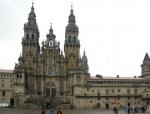
History of the Way of St. James Pilgrimage.
One etymology for the name "Compostela" is that it comes from the Latin phrase campus stellae, i.e. "field of the star", making Santiago de Compostela "St. James of the Field of the Star". This would reflect the belief that the bones of St. James the Greater were taken from the Middle East, to Spain and then buried where a shepherd had spotted a star. A church was eventually built over the bones, and later replaced with the Cathedral de Santiago de Compostela.
The legend that St James found his way to the Iberian peninsula, and had preached there is one of a number of early traditions concerning the missionary activities and final resting places of the apostles of Jesus. Although the 1884 Bull of Pope Leo XIII Omnipotens Deus accepted the authenticity of the relics at Compostela, the Vatican remains uncommitted as to whether the relics are those of Saint James the Great, while continuing to promote the more general benefits of pilgrimage to the site.
According to a tradition that cannot be traced before the 12th century, the relics were said to have been discovered in 814 byTheodomir, bishop of Iria Flavia in the west of Galicia. Theodomir was guided to the spot by a star, the legend affirmed, drawing upon a familiar myth-element, hence "Compostela" was given an etymology as a corruption of Campus Stellae, "Plain of Stars."
The 1000 year old pilgrimage to the shrine of St. James in the Cathedral of Santiago de Compostela is known in English as the Way of St.James in Galician as the Camiño de Santiago. Over 100,000 pilgrims travel to the city each year from points all over Europe, and other parts of the world.
The Way of St James has existed for over a thousand years. It was one of the most important Christian pilgrimages during medivial times. It was considered one of three pilgrimages on which a plenary indulgence could be earned, the others are the Via Francigena to Rome and the pilgrimage to Jerusalem.
The Way can take one of any number of pilgrimage routes toSantiago de Compostela. Traditionally, as with most pilgrimages, the Way of Saint James began at one's home and ended at the pilgrimage site. However a few of the routes are considered main ones. During the Middle Ages , the route was highly traveled. However, the Black Plague, theProtestant Reformation and political unrest in 16th- century Europe resulted in its decline. By the 1980s, only a few pilgrims arrived in Santiago annually. However, since then, the route has attracted a growing number of modern-day pilgrims from around the globe. The route was declared the first European Cultural Route by the Council of Europe in October 1987; it was also named one of UNESCOs World Heritage Sites.
19-03-2009 om 00:00
geschreven door Janek 
|
